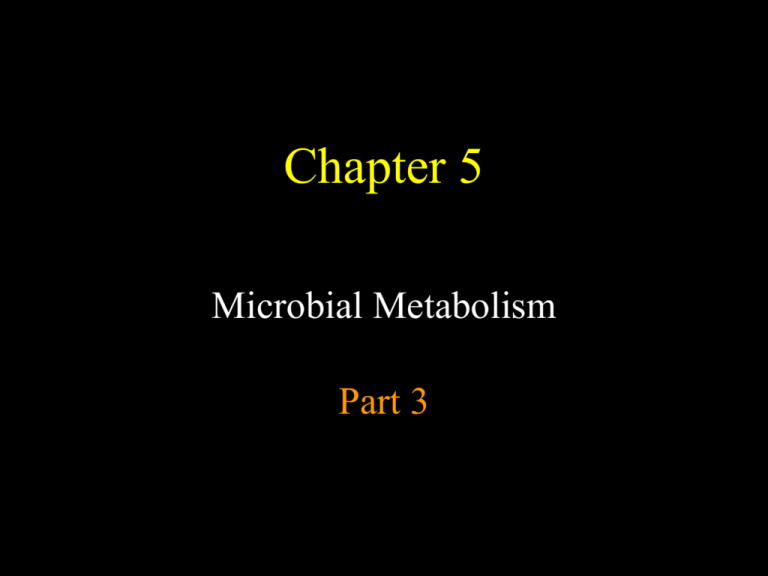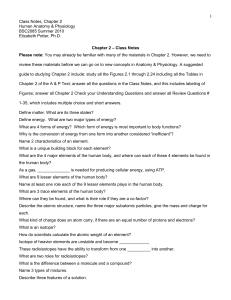Chapter 5
advertisement

Chapter 5 Microbial Metabolism Part 3 Fermentation • First stage: Glycolysis • Second stage: Reduced coenzymes (NADH & NADPH) donate their eand H+ to pyruvic acid and its derivatives to form a fermentation end products. Fig. 5.18a Fermentation • Releases energy from oxidation of organic molecules – sugars, amino acids, organic acids, purines, and pyrimidines • Does not require oxygen – bun can occur with oxygen • Does not use the Krebs cycle or ETC Fermentation • Uses an organic molecule as the final electron acceptor • Produces only small amounts of ATP – produced only during glycolysis – much of the energy remain in the chemical bonds of the organic end-products Fermentation • Second stage of fermentation ensures a steady supply of NAD+ & NADP+ so that glycolysis can continue – regeneration of NAD+ & NADP+ during fermentation can enter another round of glycolysis Figure 5.19 Fermentation • Alcohol fermentation – Produces 2 ethyl alcohol (ethanol) + 2 CO2 • Lactic acid fermentation – Produces lactic acid; can result in food spoilage – Homolactic (homofermentative) fermentation: produces lactic acid only. – Heterolactic (heterofermentative) fermentation: produces both lactic acid and other compounds (e.g. alcohol). • Use pentose phosphate pathway Fermentation Figure 5.18b Fermentation Figure 5.23 Lipid and Protein Catabolism • Lipids and proteins are oxidized for energy production (sources of electrons & protons for respiration) • Lipids (fats) = fatty acids + glycerol (ester linkage) • Lipases: extracellular enzymes that degrade fats into fatty acid and glycerol components Lipid Catabolism Beta oxidation: oxidation of fatty acids Oxidation of glycerol and fatty acids Figure 5.20 Lipid and Protein Catabolism • Proteins = amino acids (peptide bonds) • Proteases & peptidases: extracellular enzymes that break down proteins into amino acids component • Fig. 5.21 summary of carbohydrates, lipids, and protein catabolisms Protein Catabolism Protein Extracellular proteases Deamination, decarboxylation, dehydrogenation Amino acids Organic acid Krebs cycle • Deamination: removal of an amino group from an amino acid to form an ammonium (NH4+) (can be excreted from the cell) Protein Catabolism Figure 5.22 Biochemical tests • Used to identify bacteria and yeasts. – Designed to detect the presence of enzymes Figure 10.8 Photosynthesis • Used by plants and many microbes to synthesize complex organic compounds from simple inorganic substances • Photo: Conversion of light energy into chemical energy (ATP) – Light-dependent (light) reactions • Synthesis: assembly of organic molecules (using chemical energy) – Light-independent (dark) reaction, Calvin-Benson cycle Photosynthesis • Carbon fixation: synthesis of sugars by using carbons from CO2 gas (from the atmosphere) • Recycling of C by cyanobacteria, algae, and green plants via photosynthesis • Table 5.6 for summary The Light-Dependent Reactions: Photophosphorylation • Light energy is absorbed by chlorophyll in the photosynthetic cell excite some of the molecules’ electrons chemiosmotic proton pump – Chlorophyll a used by green plants, algae, and cyanobacteria (in thylakoids) – Bacteriochlorophylls used by other bacteria (chlorosomes, intracytoplasmic membrane) – Bacteriorhodopsin used by Halobacterium (purple portion of plasma membrane) Photophosphorylation • Light-dependent (light) reactions – – – – ADP + P + light energy ATP (chemiosmosis) NADP reduced to NADPH cyclic photophosphorylation noncyclic photophosphorylation • More common process Cyclic Photophosphorylation • Electron eventually return to chlorophyll Figure 5.24a Noncyclic Photophosphorylation • Electrons become incorporated into NADPH Figure 5.24b The Light-Independent Reactions: The Calvin-Benson Cycle • Light-independent (dark) reaction (CalvinBenson cycle) – use ATP along with electron produced in lightdependent reactions to reduce CO2 to synthesize sugars (carbon fixation) – complex cyclic pathway The Calvin-Benson Cycle • Go through 6 cycles to produce one glucose. * Shows 3 cycles. 6 CO2 18 ATP + 12 NADPH = 1 Glucose Figure 5.25 Summary Fig. 5.26 Metabolic diversity Among Organisms • All organisms can be classified metabolicaly according to their nutritional pattern – energy source: phototrophs vs. chemotrophs – carbon (C) source: autotrophs vs. heterotrophs • autotrophs (lithotrophs): self-feeders; use CO2 as C source • heterotrophs (organotrophs): feed on others; require an organic source of C Phototrophs • Use light as energy source. Chlorophyll Chlorophyll oxidized ETC ADP + P ATP • Photoautotrophs use energy in the CalvinBenson cycle to fix CO2; oxygenic & anoxygenic. • Photoheterotrophs use organic compounds as C source; anoxygenic. Photosynthetic process in photoautotrophs • Oxygenic (produces O2): – H atoms of H2O are used to reduce CO2 to form organic compounds, and O gas is given off • Anoxygenic (does not produce O2): – typical of cyclic photophosphorylation; anaerobic reaction – use sulfur, sulfur compounds, or hydrogen gas to reduce CO2 to form organic compounds Chemotrophs • Use chemical compounds as energy source. – Redox reactions of inorganic or organic compounds • Chemoautotroph e.g. Thiobacillus ferroxidans 2Fe2+ NAD+ 2Fe3+ NADH ETC ADP + P ATP 2 H+ – Inorganic source of energy; CO2 is C source • Energy used in the Calvin-Benson cycle to fix CO2. Chemotrophs • ATP produced by oxidative phosphorylation • Chemoheterotroph (fungi, protozoa, animals, & most bacteria) Glucose Pyruvic acid NAD+ NADH ETC ADP + P ATP – Energy source and C source are usually the same organic compound e.g. glucose • saprophytes (use dead organic matter) vs. parasites (need living host) • electrons from H atoms = energy source Metabolic Diversity Among Organisms Nutritional type Energy source Photoautotroph Light Carbon source Example CO2 Oxygenic: Plants, cyanobacteria, algae Anoxygenic: Green, purple bacteria. Photoheterotroph Light Organic compounds Green, purple nonsulfur bacteria. Chemoautotroph Chemical CO2 Iron-oxidizing bacteria. Chemoheterotroph Organic compounds Fermentative bacteria. Animals, protozoa, fungi, bacteria. Chemical Metabolic Pathways of Energy Use • Most of the ATP used in the production of new cellular components – Also used to provide energy for active transport, and flagellar motion • Anabolism in autotrophs – carbon fixation via Calvin-Benson cycle require both ATP& electrons • Anabolism in heterotrophs – need ready source of organic compounds + ATP Metabolic Pathways of Energy Use • Polysaccharide Biosynthesis • Use intermediates produced during glycolysis and the Krebs cycle & from lipids or amino acids. Figure 5.28 Metabolic Pathways of Energy Use • Lipid Biosynthesis – synthesized by variety of routes – used for structural component of membranes (e.g. phospholipids, cholesterol, waxes, carotenoids) – also used in energy storage Figure 5.29 Amino Acid and Protein Biosynthesis • Microbes with the necessary enzymes can either synthesize all amino acids directly or indirectly from intermediates of carbohydrate metabolism • Others need preformed amino acids – Supplied from Krebs cycle • amination: addition of an amino group Metabolic Pathways of Energy Use • Amino Acid and Protein Biosynthesis • Protein synthesis from amino acids involves dehydration and ATP. Figure 5.30a Metabolic Pathways of Energy Use • Amino Acid and Protein Biosynthesis – transamination: transfer of amino group from a preexisting amino acid Figure 5.30b Metabolic Pathways of Energy Use • Purine and Pyrimidine Biosynthesis • C and N atoms derived from amino acids form the purine & pyrimidine rings Figure 5.31 Integration of Metabolism • Catabolic and anabolic reactions are joined through a group of common intermediates & share some metabolic pathways (e.g. Krebs cycle) Amphibolic pathways • Are metabolic pathways that have both catabolic and anabolic functions. – Bridge the reactions that lead to the breakdown and synthesis of carbohydrates, lipids, proteins, and nucleotides Figure 5.32.1 Amphibolic pathways Figure 5.32.2




